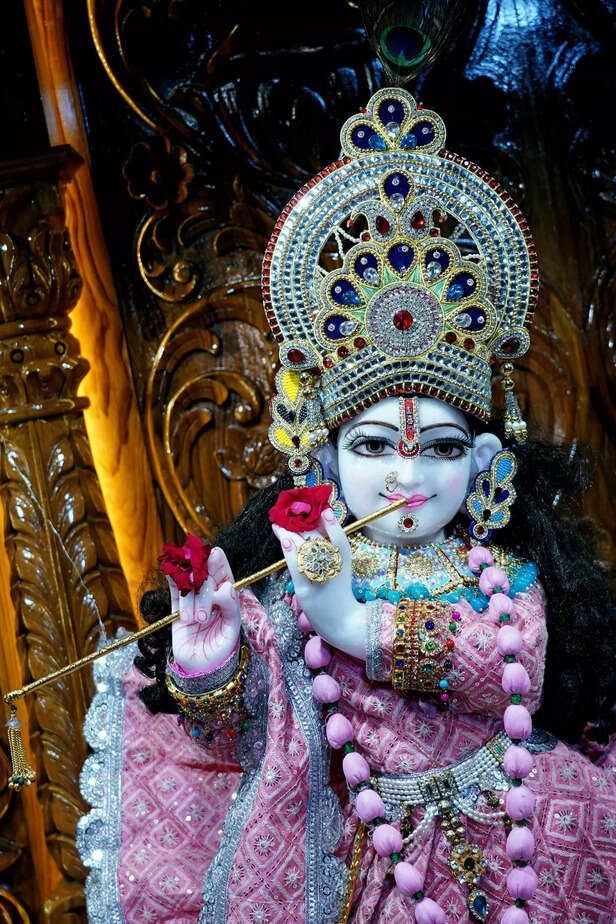Krishna in South Indian Folk Traditions and Local Legends will surprise you!
Mitali | May 16, 2025, 12:30 IST
Krishna ji with flute
Though Krishna is broadly worshipped throughout India, in South Indian folk culture, he is intensely present and rich with untold narratives. From ancient ballads in Tamil Nadu to devotional artwork in Andhra and Karnataka, this article reveals the way Krishna developed through regional perspectives. Discover the way local societies adopted, transformed, and celebrated Krishna beyond the classical texts in ways that will leave even the most experienced mythological buffs in awe.
When one hears of Lord Krishna, the first places that come to mind are Mathura, Vrindavan, or Dwarka. Yet, Krishna's stories have spread far and wide, even reaching the southernmost corners of India. South India has maintained a rich folk tradition that reimagines Krishna in local, colourful, and frequently surprising terms. These stories, rituals, and performances have made Krishna a profoundly regional god who speaks in a distinctively rural voice.

9. Krishna Festivals with Folk Origins
1. Is Krishna worshipped in South India differently from the North?
Yes, South India fuses Krishna's life stories with indigenous traditions, performing arts, and rituals, yielding a special devotional hue.
2. Are there any temples in South India with Krishna as the presiding deity?
Yes, Guruvayur in Kerala and Udupi in Karnataka are renowned Krishna temples, rooted heavily in local folk traditions.
3. Which folk art forms portray Krishna in South India?
Villupattu, Yakshagana, Krishnanattam, and Therukoothu are notable ones.
4. Was Krishna referred to in ancient Tamil literature?
Yes, particularly in Bhakti-era literature such as the Thiruppavai and Periyalvar's hymns.
5. Why is Krishna's portrayal in South Indian folk tales different?
He is drawn more human-like—sometimes naughty, sometimes heroic—often transposed to local values and everyday life.
6. Are local communities still practising Krishna folk customs today?
Yes, many villages continue practising these customs during festivals and temple ceremonies.
Krishna's passage through South Indian folk traditions is not simply a story of spiritual growth—it is a rich brocade of cultural transformation, devotional universality, and profound emotional connection. Unlike the dominant representations drawn from Sanskrit scriptures and north Indian temples, the southern vision of Krishna is close, rural, and frequently intensely personal. From the soft Tamil ballads rendered in Tamil villages to Yakshagana's melodramatic show in Karnataka, Krishna is translated into a god who talks the people's language and resides in the hearts of the people.
These local interpretations of Krishna not only deepen our knowledge of his divine self but also show the inclusive and dynamic nature of Indian spirituality. The fusion of Krishna's mythology with local tradition, regional art, and daily life demonstrates that devotion, in its purest sense, crosses boundaries and flourishes in diversity. Essentially, Krishna of South India is not only a northern god who was taken up—he is a homecoming son, reincarnated in each village legend, each folk song, and each tender oblation at the base of a village shrine.
Explore the latest trends and tips in Health & Fitness, Travel, Life Hacks, Fashion & Beauty, and Relationships at Times Life!
1. Historical Context
- Emergence of Krishna Cult in the South
- Bhakti Movement and Alvars' Role
2. Folk Traditions of Tamil Nadu
- Krishna in Tamil Ballads (Villupattu)
- Therukoothu: Krishna's Street Performances
- Devotional Contributions to Village Temples
3. Andhra Pradesh & Telangana Stories
- Gollas and Yadavas: Krishna the Cowherd King
- Bammera Potana's Bhagavatam
- Janapada Songs and Village Festivals
4. Karnataka's Folk Krishna
- Yakshagana and Krishna Tales
- Krishna in Folk Painting and Local Rituals
5. Kerala's Distinct Representation
- Krishna in Temple Arts such as Krishnanattam
- Ritual Offerings and the Guruvayur Mythos
6. Folk Deity Syncretism
- Krishna and Ayyanar: Shared Spaces in Village Shrines
- Murugan and Krishna: Blended Narratives
7. Krishna in Local Literature

Krishna
- Krishna in Sangam Literature
- Folk Epics and Oral Narration
8. Women Devotees and Krishna
- Devadasi Traditions and Krishna
- Women Poets such as Andal and Akkamahadevi
9. Krishna Festivals with Folk Origins
- Folk Celebrations of Janmashtami
- Krishna's Appearance in Village Carnivals
10. Artistic Portrayals in Folk Media
- Folk Paintings and Temple Sculptures
- Dolls and Toys: Bommai Golu and Krishna
11. FAQs: Krishna in South Indian Folk Traditions
Yes, South India fuses Krishna's life stories with indigenous traditions, performing arts, and rituals, yielding a special devotional hue.
2. Are there any temples in South India with Krishna as the presiding deity?
Yes, Guruvayur in Kerala and Udupi in Karnataka are renowned Krishna temples, rooted heavily in local folk traditions.
3. Which folk art forms portray Krishna in South India?
Villupattu, Yakshagana, Krishnanattam, and Therukoothu are notable ones.
4. Was Krishna referred to in ancient Tamil literature?
Yes, particularly in Bhakti-era literature such as the Thiruppavai and Periyalvar's hymns.
5. Why is Krishna's portrayal in South Indian folk tales different?
He is drawn more human-like—sometimes naughty, sometimes heroic—often transposed to local values and everyday life.
6. Are local communities still practising Krishna folk customs today?
Yes, many villages continue practising these customs during festivals and temple ceremonies.
These local interpretations of Krishna not only deepen our knowledge of his divine self but also show the inclusive and dynamic nature of Indian spirituality. The fusion of Krishna's mythology with local tradition, regional art, and daily life demonstrates that devotion, in its purest sense, crosses boundaries and flourishes in diversity. Essentially, Krishna of South India is not only a northern god who was taken up—he is a homecoming son, reincarnated in each village legend, each folk song, and each tender oblation at the base of a village shrine.
Explore the latest trends and tips in Health & Fitness, Travel, Life Hacks, Fashion & Beauty, and Relationships at Times Life!
